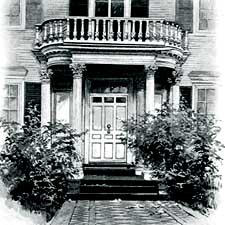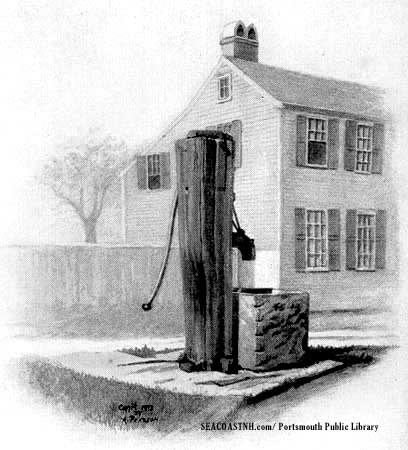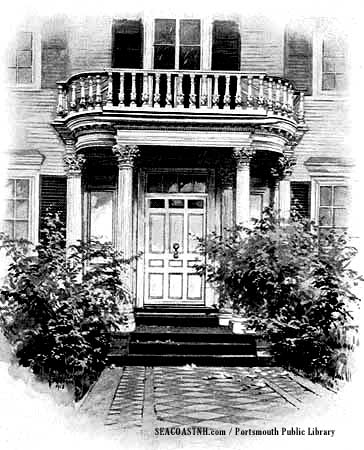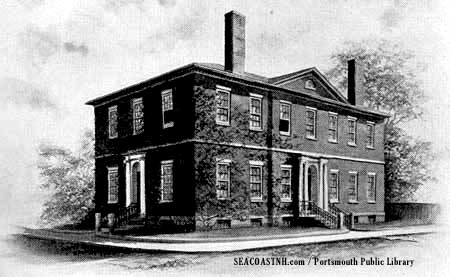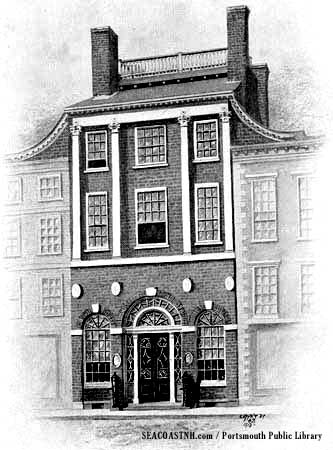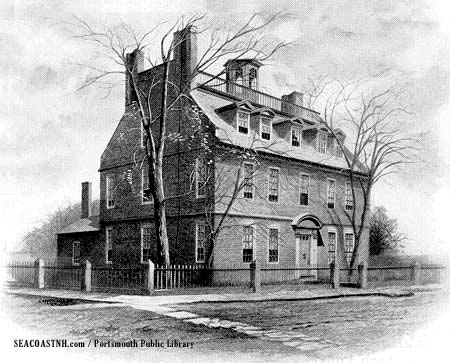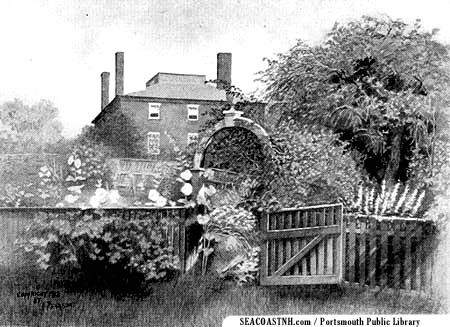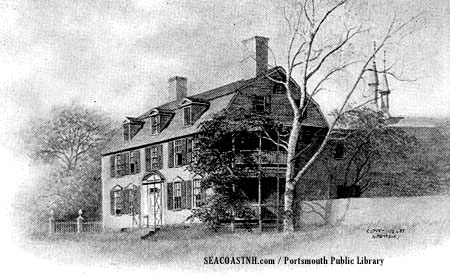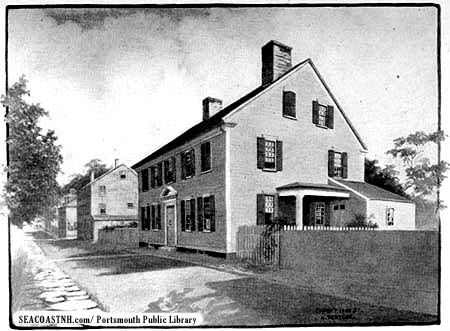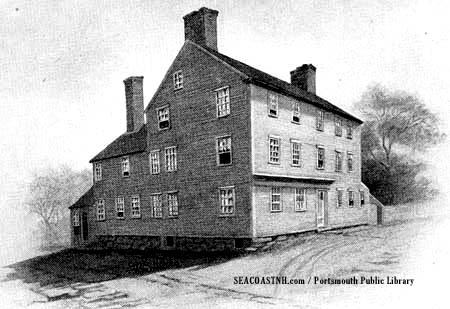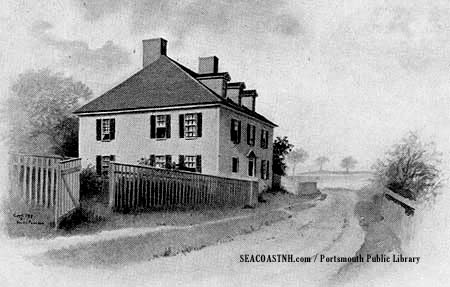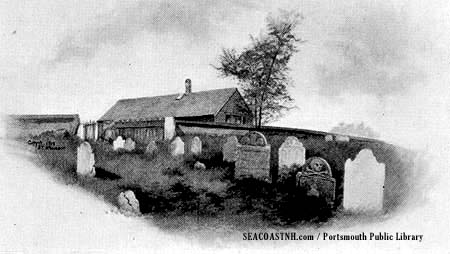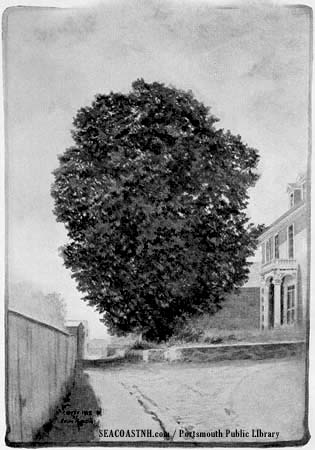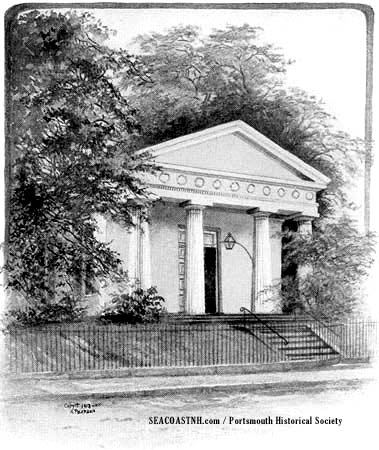|
FRESH STUFF DAILY |
|
|
||
|
|
||
|
|
||
|
SEE ALL SIGNED BOOKS by J. Dennis Robinson click here |
||
Helen Pearson’s pencil sketches remain among the best images ever made of her beloved Portsmouth. This little souvenir book from 1913 still pops up in used bookstores, but you don’t have to go searching. Here are half of the images in a clickable page format with the text from the original booklet.
FOLLOWING PAGES INCLUDE: Old Meeting Hill Pump, Langdon House, Portsmouth Public LIbrary, Portsmouth Athenaeum, MacPhaedros-Warner House, Moffatt-Ladd House, Lord House, Nutter House, William Pitt Tavern, Lear House, Point of Graves, Old Linden Tree and St. John's Chapel. Most of the early Portsmouth touring books include photographs, but Helen Pearson did something different. Her 1913 "Vignettes of Portsmouth" featured her warm evocative pencil sketches. The little booklet of nearly two dozen images appeared as a cloth-covered paperback with text by Harold Hotchkiss Bennett. Although many of the images have re-appeared in articles and books since, to our knowledge, it has never been reprinted. Because it was a delicate booklet, copies show up only rarely in used book stores. According to Vaughan, brother Dan Pearson (neither married) may have been an inventor. He reportedly designed the mechanism for coupling railroad cars that may have provided the income for the Pearsons. While Dan was highly mechanical, sister Helen was artistic and had attended art school in Boston. It is worth speculating whether Helen Pearson had met the "grandmother of Portsmouth tourism" Sarah Foster, whose Civil War-era pocket guide to Portsmouth historic houses was a runaway bestseller locally. Foster, like Pearson, had painted the region's historic homes and both also had a passion for painting flowers. Foster lived on Richards Ave. near Broad Street, never married, and was struck and killed by one of the town's first trolley cars in 1900. Pearson may have been carrying Foster's work into the next century. Pearson bequeathed the original images in "Vignettes" to the Portsmouth Public Library where they remain today, archived on the same shelf as the original oil paintings of her predecessor Sarah Foster. The work of both artists deserves to be rediscovered, reprinted, studied and displayed. In this online gallery of Pearson's work we have included, not only the pencil images from "Vignettes", but also some of the accompanying text from the original booklet. By Harold Hotchkiss Bennett may include information no longer considered accurate today. -- JDRBy J. Dennis Robinson Text copyright (c) 2005 by SeacoastNH.com. Originally published here 1999. CONTINUE to next VIGNETTE
In the year 1657, the town meeting, August 27, empowered the selectmen, among whom were' John and Richard Cutt, to build a new meeting house "40 feet square, with twelve windows, 3 substanciall doors and a complete pulpit." The building had neither shutters nor pews, and was erected "at the crotch of the roads leading to the Pound and Frame Point two or three rods to the southward of the Mill Dam." In 1658, Reverend Joshua Moody began his ministerial labors at first supported by subscription, and settled formally by vote of the town in 1660. That dangers existed in the early town is seen in the vote of September 25, 1662, "that whoever shall kill a wolf within the bounds of this town, and shall nayle the head of said wolf killed upon the meeting house, he shall have five pounds for his paynes to be paid by the treasurer." In the year 1664, the town meeting of April 18 authorized the Selectmen to hang the bell, the earliest church bell in New Hampshire. On July 24, 1671, John Pickering agreed with the Selectmen "to build a cage, twelve feet square, with stocks within it and a pillory on the top, a convenient space from the west end of the meeting house," and he also agreed "for thirty shillings to make shutters for the windows to draw backwards and forwards." In the following year, a town meeting, held March 12, voted "that, if any shall smoke tobacco in the meeting house, at any public meetings he shall pay a fine of five shillings for the use of the town." Not until 1693 was provision made for the installation of pews, and seats were assigned to each individual in the town, the men carefully divided from the women, and the younger persons given still other places. In 1712, a meeting house erected on the site of the present North Church was completed pursuant to the order given in the town meeting of September 4, 1711, when it was voted by a majority of the townspeople "to build a new meeting house on the corner of the Glebe, which should be the stated meeting house of the town." A large minority opposed the removal, and amid a discussion which is echoed in the town records well into the middle of the eighteenth century, voted to remain in the old meeting house, whither they called the Reverend John Fmerson of Newcastle. This Society, thereafter called the South Parish, upon the completion of their new church in the lot presented by John Pickering, removed in 1732 from his structure. The building was then taken down and one half moved to Congress Street to serve as a store until the year 1846. NOTE: Text includes only information popularly known at the time of its publication. Excerpt from "Vignettes of Portsmouth," (1913) Illustrated by Helen Pearson with text by Harold Hotchkiss Bennett, Courtesy of Portsmouth Public Library Collection. Published here courtesy of SeacoastNH.com. CONTINUE to next VIGNETTE
This stately mansion was built in the year 1784, by Governor john Langdon and occupied by him until his death, on September 18, 1819. A venturous life of unusual interest began when the future patriot was two years old and dwelt in his ancestral home near the crossing of Lafayette and Elwyn Roads, for in the year 1741 the house was consumed by fire and the child was saved from destruction by being thrown from a window down upon a snow bank. After school days at Major Hale's on State Street and further education in the counting-room of Daniel Rindge, John Langdon engaged in a sea-faring life until the Revolutionary troubles enlisted his ready support. In the year 1774, with Captain John Pickering and Major Sullivan, he led in the daring midnight capture of Fort William and Mary, recorded in British Annals as the first action of the rebels against British soldiery, preparatory to the War of the Revolution. " In the years 1775 and 1776, he was a delegate to the General Congress and as commander of an independent body of cadets was present at Burgoyne's surrender. He was a member and speaker of the Provincial Legislature of 1776 and 1777 in session at Exeter. When the fall of Fort Ticonderoga led to a decline in the public credit and general discouragement at the country's situation, addressing the Representadves, he made his stirring pledge to the cause of freedom: "I have a thousand dollars in hard money; I will pledge my plate for three thousand more. I have seventy hogsheads of Tobago rum which will be sold for the most they will bring. They are at the services of the State. If we succeed in defending our firesides and our homes, I may be remunerated; if we do not, then the property will be of no value to me. Our friend Stark, who so nobly maintained the honor of our State at Bunker Hfll may safely be trusted with the honor of the enterprise and we will check the progress of Burgoyne." From this noble offer came the gallant little New Hampshire army that turned back the British northern invasion at Bennington. Holding many National offices of trust, and frequently elected to State and National Legislatures, John Langdon was chosen President of the United States Senate at its first session, and in that capacity declared the vote of the nation which elected Washington President, and AdamsVice-President of the United States, administering to them their oaths of office. After serving the State as Governor from I 805-I8II, with the exception of the year I809, he declined the National Vice-Presidential nomination from the Republican Congressional Caucus in I8I2, thereafter retiring from public affairs cc and passed the evening of his days in calm retreat from the business of politics and contending parties. Aside from being the residence of a man so famous in his day, this mansion gains interest from the notable guests who have passed within its doors. President Washington's diary, kept during his visit in 1789, notes that on the day of his arrival, October 31st, after a day of public receptions, he "drank tea at Mr. Langdon's." On Monday, November 2d, he "dined at Colonel Langdon's and drank tea there with a large circle of ladies." Just before leaving Portsmouth, and noting his impressions, he writes, "There are some good houses, among which Colonel Langdon's may be esteemed the first." At the time of the French Revolution, the three sons of the Duke of Orleans, among them Louis Phillipe, the future King of France, took refuge in the new republic, and coming to Portsmouth found the I "William Pitt " unable to accommodate them, whereupon they took quarters with Governor Langdon. Years afterward, when a Portsmouth lady was presented to King Louis Phillipe he remembered his visit and made inquiry, "Is the pleasant mansion of Governor Langdon still standing?" Another Presidential guest at the Governor's hospitable hall was President Munroe, who called here at the time of his visit to Portsmouth in the year I817. Following his illustrious predecessors, President William H. Taft called at the Governor's mansion when in the city of Portsmouth, October 23, 1912. After Governor Langdon's death, Reverend Doctor Burroughs, Rector of St. John's Church for forty-five years, resided in the house, but in recent years (written in 1913) it has returned to the family of its first owner. UPDATE: The Langdon House is now part of Historic New England and open to the public for tours in season. NOTE: Text includes only information popularly known at the time of its publication. Excerpt from "Vignettes of Portsmouth," (1913) Illustrated by Helen Pearson with text by Harold Hotchkiss Bennett, Courtesy of Portsmouth Public Library Collection. Published here courtesy of SeacoastNH.com.
CONTINUE to next VIGNETTE
Built in 1809, from the designs of renowned architect, Charles Bulfinch, for the proprietors of the Portsmouth Academy, this building was used by that scholastic body until 1868, when it was sold to the city for a public school. Since the year of 1896, the Portsmouth Public Library has used the building. (Important SeacoastNH.com Update: According to Richard Candee's book "Building Portsmouth" (1992), the popular belief that Bulfinch designed this building is false, although the structure is still routinely referred to as "the Bulfinch Library." Records indicate that the actual designer was named James Nutter. This is the site where this and other Helen Pearson original pencil sketches in "Vignettes" are archived today.) UPDATE: The library is moving to a new location nearby and is available at the City of Portsmouth web site
NOTE: Text includes only information popularly known at the time of its publication. Excerpt from "Vignettes of Portsmouth," (1913) Illustrated by Helen Pearson with text by Harold Hotchkiss Bennett, Courtesy of Portsmouth Public Library Collection. Published here courtesy of SeacoastNH.com.
CONTINUE to next VIGNETTE
Incorporated by the Legislature of the state in 1803, the New Hampshire Fire and Marine Insurance Company erected this building in that year, and occupied it until the suspension of the company, caused principally by its losses in the War of 1812. In 1817, the property was purchased by the Portsmouth Athenaeum, a group of gentlemen who had formed an association to promote a public library. This is not a valuable collection of books, original manuscripts and Portsmouthiana. (SeacoastNH.com Update: Today the Athenaeum remains a private library supported by over 300 proprietors. It is open on select hours to the public three times each week.) NOTE: Text includes only information popularly known at the time of its publication. Excerpt from "Vignettes of Portsmouth," (1913) Illustrated by Helen Pearson with text by Harold Hotchkiss Bennett, Courtesy of Portsmouth Public Library Collection. Published here courtesy of SeacoastNH.com.
CONTINUE to next VIGNETTE
This house, which at the time of building "was scarcely surpassed by any private residence in New England," was built by Captain Archibald MacPheadris, native of Scotland, member of the King's Council in 1722, and a prominent merchant. He was a leader in the first iron works in America, when the Lamprey River Iron Works were established under charter from the general court of Massachusetts in 1719, with a grant of land two miles wide at the Dover line. It is interesting to note that this land came into the possession of the town of Portsmouth as a result of the town's liberal contribution to Harvard College in 1672, after the burning of the library. In 1719, for the purpose of obtaining fuel, and for providing residences for workmen, whom the company intended to secure in Europe, the town asked an order from the General Court "for laying out the six mile square of land at the head of Oyster River, formerly granted by Massachusetts to the town of Portsmouth." The location of the land and the ancient business venture are preserved in the name of Gilmanton Iron Works. This mansion was commenced in 1718 and finished in 1723 at an expense of 6,000 pounds. The brick used in the construction of the eighteen-inch walls was brought from Holland, with other of the materials. Marrying Sarah, one of the sixteen children of Lieutenant Governor John Wentworth, Captain MacPheadris lived in his house but six years, for in 1729 he died, leaving a daughter, Mary. She married in 1754, Honorable Jonathan Warner, who was King's Councillor until the Revolution annulled his commission. The hall of the house has most interesting frescoes of unknown origin, representing various subjects; Governor Phipps on his charger, a lady at a spinning-wheel, a representation of Abraham offering up Isaac, and numerous others, which were covered by four layers of wall paper, and were accidently discovered about i850, when the removal of a small piece of the covering revealed a painted horse's hoof. In the hall hang enormous elk antlers presented to Captain MacPheadris by his Indian friends while portraits of two Indians are supposed to picture the hunters with whom the first owner dealt in furs. "The lightning rod on the west end of the house was put up in 1767 under the personal inspection of Doctor Benjamin Franklin, and was probably the first put up in New Hampshire."
UPDATE: The Warner House is now an independent House museum. NOTE: Text includes only information popularly known at the time of its publication. Excerpt from "Vignettes of Portsmouth," (1913) Illustrated by Helen Pearson with text by Harold Hotchkiss Bennett, Courtesy of Portsmouth Public Library Collection. Published here courtesy of SeacoastNH.com.
CONTINUE to next VIGNETTE
The house, now in the possession of The Society of the Colonial Dames of New Hampshire, was built in 1763 by Captain John Moffat, who had come to America as commander of one of the King's mast ships which took, for use in the Royal Navy, their cargoes of masts in Pepperell's Cove at Kittery Point. Captain Moffat married Catherine, daughter of Robert Cutt, 2d, and settled in Portsmouth, where he prospered and lived to the age of ninety-four years. The year after the completion of the house, Captain Moffat's son Samuel married Sarah, daughter of Colonel John Tufton Mason, descendant of the Provincial Proprietor, and lived here five years. At that time his business of ship owner was so unprofitable that he failed, and to avoid the severe debtor laws fled to the West Indies. At the sale of the house, Captain John Moffat bid it in, and moved hither from what is now State Street, bringing his daughter, Catherine, who later married General William Whipple. General William Whipple was born in Kittery in 1730, and early followed the career of a sailor. Before he was twenty-one he had command of a vessel and made many voyages to Europe and the Indies, as well engaging in the slave trade and importing negroes from Africa. Leaving the sea in 1759, he was engaged in trade with his brother, when the growing discontent of the Colonies enlisted his sympathies. Elected a member of the Congress which met in Philadelphia in 1775, he was chosen member of the Provincial Congress, which assumed the government after the commencement of hostilities. Re-elected to Congress in 1776, he signed the Declaration of Independence. The following year, he was given by the State command of the First Brigade of its militia, and marched against Burgoyne, but soon after his arrival in camp the British general surrendered. Whipple was selected as one of the officers to guard the captive troops to Winter Hill near Boston. Serving after the Revolution as judge of the Supreme Court, he died very suddenly November 10, 1785, leaving no children. Tradition affirms that he personally planted the horse chestnut trees now before the house. The following year, Captain John Moffat died, and the estate was plunged into a long litigation. The court finally decided in favor of the executors and against Madame Whipple, who removed to the Plains, leaving Robert Cutt, a son of Samuel Moffat, in possession. Doctor Nathaniel A. Haven, Member of Congress, later purchased the estate from Moffat, and gave it to his eldest daughter, Mary Tufton, the wife of Alexander Ladd, whose descendants held the property until the recent (note: written in 1913) conveyance to the Society of the Colonial Dames. The house was the first square three-story house in New Hampshire, and is of unusual architectural interest. The hall is a reproduction of the hall in Captain Moffat's father's house in England, and the carved mantelpiece in the living-room was attributed to Grindling Gibbons, a celebrated architect of about 1666. Almost as well known as General Whipple in Portsmouth were two of his slaves, Prince and Cuffee. Brought from Africa before 1766, when they were about ten years old, the General took Prince with him on the expedition against the British, and gave him his freedom at that time. After the General's death, Prince and Cuffee lived in a small house, on land given them at the foot of the garden on High Street. UPDATE: The Moffatt-Ladd House is still owned by the Colonial Dames and still open to the public on Market Street. NOTE: Text includes only information popularly known at the time of its publication. Excerpt from "Vignettes of Portsmouth," (1913) Illustrated by Helen Pearson with text by Harold Hotchkiss Bennett, Courtesy of Portsmouth Public Library Collection. Published here courtesy of SeacoastNH.com.
CONTINUE to next VIGNETTE
Honorable John Langdon later owned the house, then Samuel Lord, Cashier of the Piscataqua Bank, and its successors, for fifty years; during part of which time he as also Treasurer of the Portsmouth Savings Bank. (Note: Four years after the publication of "Vignettes" the Lord House became the home base of the new Portsmouth Historical Society in 1917 and remains open to the public today.) VISIT the Portsmouth Historical Society web site or our John Paul Jones section. NOTE: Text includes only information popularly known at the time of its publication. Excerpt from "Vignettes of Portsmouth," (1913) Illustrated by Helen Pearson with text by Harold Hotchkiss Bennett, Courtesy of Portsmouth Public Library Collection. Published here courtesy of SeacoastNH.com CONTINUE to next VIGNETTE
Known to all readers of the incomparable "Story of a Bad Boy" as the Nutter House, this was the boyhood home of Thomas Bailey Aldrich, owned by his grandfather, and, by his statement, erected by about the middle of the eighteenth century. Used as a home by the Society for the Benefit of Orphan and Destitute Children from 1877-1883, then as a hospital, until the present Cottage Hospital was constructed, the building was purchased by the Thomas Bailey Aldrich Memorial Association in 1908 And carefully refurnished in minutest detail according to the manner of the "Bad Boy's" home VISIT our Thomas Bailey Aldrich section. The house is now part of Strawbery Banke Museum. NOTE: Text includes only information popularly known at the time of its publication. Excerpt from "Vignettes of Portsmouth," (1913) Illustrated by Helen Pearson with text by Harold Hotchkiss Bennett, Courtesy of Portsmouth Public Library Collection. Published here courtesy of SeacoastNH.com CONTINUE to next VIGNETTE
This building on land purchased from Hon. Theodore Atkinson in 1765, was built in 1770 by John Stavers and opended "for the accommodation of genteel travelers." It was called the "Earl of Halifax," second of the name, and as the proprietor was an Englishman by birth, it came to be the meeting place of the Portsmouth Tories and Officers of the Crown. The jealousy of the Sons of Liberty was so aroused that on a day in 1777 a mob surrounded the hotel and, with an axe, made an attack upon the foot of the sign post. Mr. Stavers gave a like weapon to one of his black slaves, directing him to defend the property, and to cut down anyone who molested it. A blow on the head of the patriot axe-wielder, which made him insane for the following forty years of his life, brought down the wrath of the mob forthwith upon the establishment. The terrified slave was discovered, after long search, standing immersed to his chin in a rain barrel in the tavern cellar; the landlord was found to have fled on unsaddled steed in the direction of Greenland, whence two riders were sent in pursuit, and after the mob had departed, the tavern was left signless, windowless and desolate. After the excitement of the populace had been calmed by Captain Langdon and other patriots, Stavers was induced to return, whereupon the Committee of Safety seized him and placed him in Exeter jail. Upon taking the oath of allegiance, he came once more to his hotel, refitted it, replaced the "Earl of Halifax" with "William Pitt," and soon had the good will of his fellow citizens and the patronage of the country's men at arms. In 1782, when the French fleet rode in Portsmouth harbor, the Marquis De Lafayette came here from Providence to visit some of its officers. Here, too, have stayed John Hancock, Elbridge Gerry and General Knox. In the time of the French Revolution there called Louis Philippe and his two brothers, but finding the hotel full, they took quarters with Governor Langdon. In the year 1789, President Washington made a final complimentary visit upon General John Sullivan, President of New Hampshire, and his Council at the "William Pitt." In the upper room of the hotel were held for several years the meetings of St. John's Lodge, Portsmouth's historic Masonic Organizadon, and also the early meetings of the Grand Lodge of New Hampshire.
VISIT the William Pitt Tavern now in Strawbery Banke Museum NOTE: Text includes only information popularly known at the time of its publication. Excerpt from "Vignettes of Portsmouth," (1913) Illustrated by Helen Pearson with text by Harold Hotchkiss Bennett, Courtesy of Portsmouth Public Library Collection. Published here courtesy of SeacoastNH.com CONTINUE to next VIGNETTE
Here was born in 1760, Tobias Lear, son of Captain Tobias Lear, shipmaster and owner of the old Jacob Sheafe farm at Sagamore Creek. The son was graduated with honor at Harvard College in 1783. At this time, General Washington requiring the services of a private secretary, who could also act as tutor for the two children of Parke Custis, whom he had adopted, engaged Tobias Lear, upon the recommendation of General Lincoln, of Boston, and the Reverend Doctor Haven. For sixteen years, or until the end of Washington's life, "the secretary lived as a son at Mt. Vernon, and at the final scene was the chosen attendant to administer such help as could be given." It was a letter of Tobias Lear's that communicated to President Adams, and through him to Congress, the information of Washington's death. At the time of Washington's visit to Portsmouth, the President came to this house on November 3, 1789, to call upon Mrs. Lear, stepmother of the secretary, and Lear's sister, who had married Samuel Storer. Their son, christened George Washington, was presented to the President, who expressed the wish, that he may be a better man than the one whose name he bears." In after life he was a Rear-Admiral in the navy. In 1798, when Washington accepted the command of the Provincial Army, Mr. Lear was selected as the military secretary with the rank of colonel. After the death of Washington, and upon the accession of President Jefferson, Colonel Lear was Consul General at St. Domingo. Later, in the year 1804, as Consul General at Tripoli, he acted with Commodore Barron in negotiating peace with that country. He remained in Algiers about eight years, and in 1812, when the Barbary powers declared war, he was allowed but a few hours to leave the country. Returning to Washington, he was appointed accountant in the War Department, in which office he died very suddenly October 10, 1816.
VISIT our Tobias Lear web section NOTE: Text includes only information popularly known at the time of its publication. Excerpt from "Vignettes of Portsmouth," (1913) Illustrated by Helen Pearson with text by Harold Hotchkiss Bennett, Courtesy of Portsmouth Public Library Collection. Published here courtesy of SeacoastNH.com CONTINUE to next VIGNETTE
On March 2, 1671, Captain John Pickering agreed "that the towne shall have full libertie without any molestation to inclose about about half an acre on the neck of land on which he now liveth, where the people have been wont to be buried, which land shall be impropriated forever for the use of a burying place, only the said Pickering and his heirs forever, shall have libertie to feet the sane with neat cattle." Here is the burial place of Lieut. Governor Vaughan, and his contemporaries; here too is the grave of Secretary Tobias Lear. The eldest stone now standing is dated 1682. (Note: Lear died by his own hand at his home is Virginia, and it is his father at Point of Graves. Secretary Lear was the fifth Lear in a row named Tobias.) UPDATE: Point of Graves is still intact near Prescott Park and across from Strawbery Banke just before Peirce Island and Mechanics Street in the South End. NOTE: Text includes only information popularly known at the time of its publication. Excerpt from "Vignettes of Portsmouth," (1913) Illustrated by Helen Pearson with text by Harold Hotchkiss Bennett, Courtesy of Portsmouth Public Library Collection. Published here courtesy of SeacoastNH.com CONTINUE to next VIGNETTE
Built in the year 1760, by Madam Mark Hunking Wentworth for her son Thomas, this mansion came into the possession of Major William Gardner in 1792. Born in 1751, he had followed the custom of the period and entered a counting house for his business education, in his case the office of Colonel Joshua Wentworth at the corner of Vaughan and Hanover Streets. During the Revolution, he was an Acting Commissary furnishing supplies to the army. It is related that at one period of the war he was called on for blankets, of which there were none in Portsmouth. At Newburyport Major Gardner found a stock, but the merchant was unwilling to sell. Said he, "The government is so much in debt to me that, if the Revolution is not carried, I am a ruined man. I cannot trust the government any further, but if Major Gardner will take them upon his own personal note, he can have them." To have a reputation for solvency greater than that of the United States government is a distinction not many of its citizens have possessed. In point of fact, the Major found an empty national treasury to meet his claims, and was so sore a sufferer for his sacrifices at the end of the war, that President Washington appointed him Commissioner of Loans and Pension Agent. His office was over an arch which spanned the present Gardner Street, a well-known landmark in the old town. When Adams came into power and made a sweeping change of government office holders, the Major was removed, to his great indignation. He became more ardently republican than ever, and was rewarded by having his office restored in 1897 by Thomas Jefferson, being allowed to keep it as long as it existed. The major died in 1833, "one of the most honorable and respected of our citizens." The magnificent linden tree which stands before the house is well over two hundred years old. (SeacoastNH.com Update: In fact, after all this explanation, the Linden tree and counting house arch are gone, but the extraordinary Georgian-style mansion, latter owned and made world famous by photographer Wallace Nutting, is open to the public each summer.) UPDATE: For more on this story see Recycling Old Trees NOTE: Text includes only information popularly known at the time of its publication. Excerpt from "Vignettes of Portsmouth," (1913) Illustrated by Helen Pearson with text by Harold Hotchkiss Bennett, Courtesy of Portsmouth Public Library Collection. Published here courtesy of SeacoastNH.com CONTINUE to next VIGNETTE
Upon the site where once stood the house of Reverend John Emerson, later owned by Jacob Sheafe and destroyed in the fire of 1813, this chapel was erected in 1832. The Brattle Organ, used to the present day in the chapel (Note: written in 1913), was installed four years later. This historic instrument was brought to Boston in August, 1713, and presented to the Queen's Chapel by Thomas Brattle, Esq. So great were the public prejudices against instrumental music that the organ remained in the porch of the church for seven months unpacked, In 1714, however, it was put up and regularly used in that church, which, after Queen Anne's reign ended, received the name it now bears of the King's Chapel. In 1756, the organ was sold to St. Paul's Church, Newburyport, where it was used eighty years, then sold once more and put up at St. John's Church. This instrument, with its original pipes and wind chest even now in perfect order, was the first organ introduced into New Engand, and probably the first erected in any of the Colonies. (SeacoastNH.com Update: The copy above refers largely to St. John's on Chapel Street. We could not find the chapel until we discovered the 1832 Grecian-style chapel was torn town to make way for an office building in the 20th century. It was used as a church school for bible study.) NOTE: Text includes only information popularly known at the time of its publication. Excerpt from "Vignettes of Portsmouth," (1913) Illustrated by Helen Pearson with text by Harold Hotchkiss Bennett, Courtesy of Portsmouth Public Library Collection. Published here courtesy of SeacoastNH.com Please visit these SeacoastNH.com ad partners.
News about Portsmouth from Fosters.com |
| Thursday, April 18, 2024 |


|
Copyright ® 1996-2020 SeacoastNH.com. All rights reserved. Privacy Statement
Site maintained by ad-cetera graphics

 Smuttynose Murders
Smuttynose Murders



